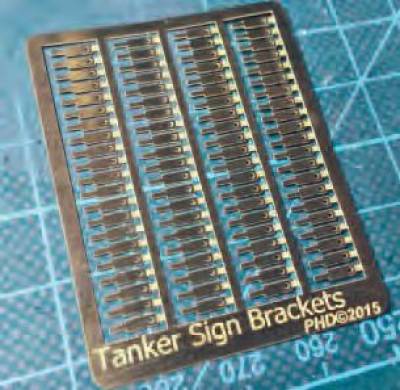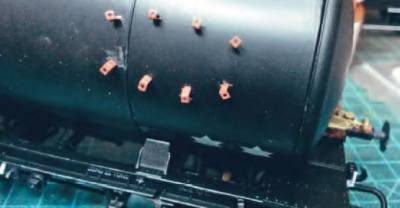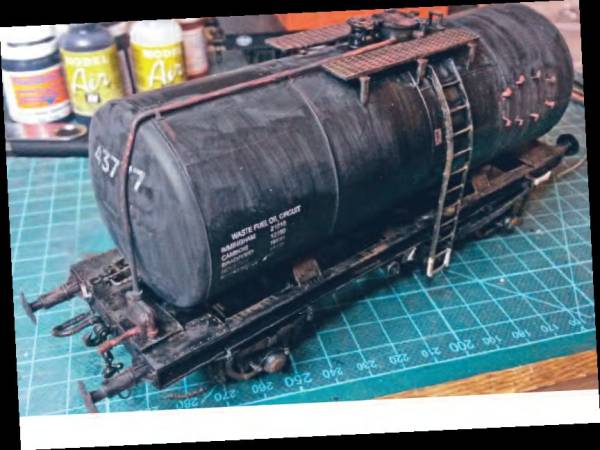Improving the Heljan waste oil tank wagon
| Failed to open database: gaugegu1_gog2 | ret is false |
Stephen Young
The Heljan waste oil tank wagon provides the modeller with the opportunity to run something a little different, especially as these wagons run in short trains from their base MPD to the waste disposal facility at Immingham.
Heljan have based their model on an ex-Esso Class B 35ton air-braked wagon numbered 43777, TOPS code ZRW ADB 999074. The prototype is currently at the Northampton and Lamport Railway where it has been recently restored. Details can be found on their webpages at www.nlr.org.uk/about-nlr/stock-list/wagons/esso-tank-wagon-№-3777/. A good series of general and detail photographs of the wagon taken by Andy Jupe prior to the restoration can be found at http://gingespotting.smugmug.com/DetailShots/Wagon/ZRW/.
 The first stage of the project was straightforward. Just Like the Real Thing make a lost-wax brass casting of the pipe work for the end of the barrel. Fitting this is simply a matter of using the supplied measurement guide to drill two holes in the barrel of the wagon then applying a couple of spots of CA adhesive (Fig 1).
The first stage of the project was straightforward. Just Like the Real Thing make a lost-wax brass casting of the pipe work for the end of the barrel. Fitting this is simply a matter of using the supplied measurement guide to drill two holes in the barrel of the wagon then applying a couple of spots of CA adhesive (Fig 1).
 Fig 1. The JLTRT casting attached to the end of the barrel
Fig 1. The JLTRT casting attached to the end of the barrel
The second stage was to fit the brackets on the barrel side that support the ESSO logo plate. These can be obtained from Pete Harvey, PH Design, as a very nice brass etch that will give you enough to do several tank wagons (Fig 2). The difficulty with this job is to accurately place the brackets. One way is to do as Brian Daniels did using the ESSO plate as a guide for drilling the holes for the brackets.
 Fig 2. Design etch for the brackets. You get sufficient for
eight tank wagons plus spares
Fig 2. Design etch for the brackets. You get sufficient for
eight tank wagons plus spares
However, I noticed on close inspection that if you hold the wagon at an angle against the light and glance across the
barrel there is a series of 'blemishes' in the surface finish. These may be mould marks but they are certainly in the correct positions for the brackets. It makes me wonder if Heljan had originally intended to represent the brackets. I used a 0.7mm drill to carefully make the holes. The brackets are removed from the etch and folded up before fixing with a spot of CA adhesive (Fig 3).
 Fig 3. Brackets in place and primed
Fig 3. Brackets in place and primed
The third stage was to make the air pump and pipe work used to fill the tank wagon from depot storage tanks. These parts were scratch built from scraps of plastic and lengths of wire. I don't claim that the pump is an accurate model as I could not find a decent close-up photograph of a pump. Figures 4 and 5 show this work, and Figures 6, 7 and 8, the finished items.
 Fig 4. The filter pipe is made from a piece of steel wire and goes into a hole drilled in the side of the turret. The fastening straps are made from strips of masking tape.
Fig 4. The filter pipe is made from a piece of steel wire and goes into a hole drilled in the side of the turret. The fastening straps are made from strips of masking tape.
 Fig 5. The air pump was made from oddments of plastic pipe, wire with wraps of masking tape to represent the joints and sits on a peice of thin Plastikard.
Fig 5. The air pump was made from oddments of plastic pipe, wire with wraps of masking tape to represent the joints and sits on a peice of thin Plastikard.
 Fig 6. Close up of the finished brackets
Fig 6. Close up of the finished brackets
 Fig 7. The painted and weathered tank wagon with Railtec transfer
for #43777
Fig 7. The painted and weathered tank wagon with Railtec transfer
for #43777






